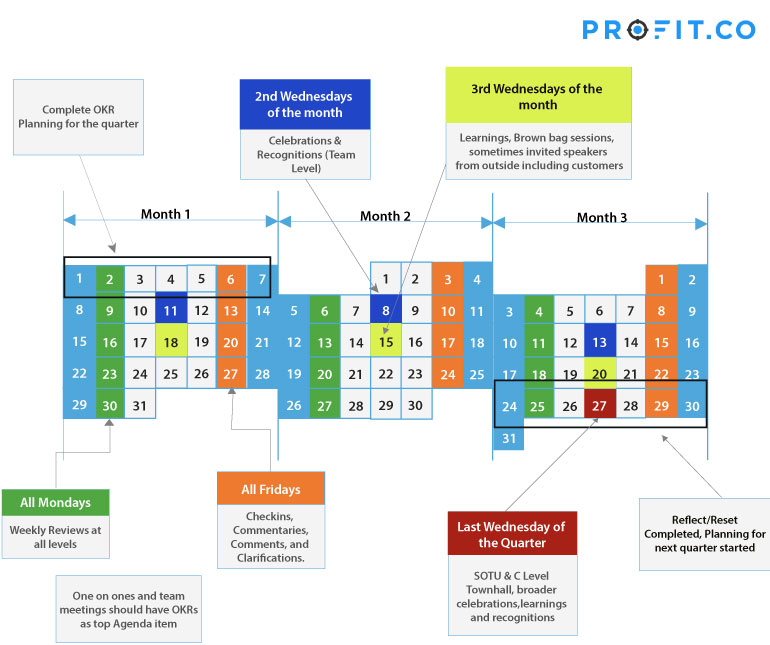An OKR quarter can be pretty well structured when you have a very mature OKR program. Mature OKR program clearly implies that you are not going to get there in your first quarter. It could take 2-3 quarters to get there. But, it would be great to visualize what that quarter would look like, and that vision will guide you to get there sooner.
We have a typical quarter outlined in the image below.

Again, we referred to a typical quarter. We are not really saying that your quarter has to be structured exactly like this. But this is one implementation that you can use as a starting point and tweak it with your own preferences and situations to get your quarterly OKR calendar established. And also, there might be other things that you can add to this to make things better.
In this particular OKR quarter, the three months are defined as follows:
- Month one with 31 days.
- Month two with 30 days.
- And month three, again with 31 days.
We’ll organize the key dates in this calendar around our PEEL cycle to illustrate how the PEEL cycle overlays beautifully over your OKR quarters.
Plan
You start your quarter with your plan for the quarter. You cannot take a month to plan your quarter. It goes without saying that, that would be a disaster. You should get your plan for the quarter in order by the end of the first week.
Now, this could seem very idealistic and not practical, especially when you are at the beginning of your OKR journey. It actually is not. It’s just a good goal to strive for. It might take two, three, four quarters for you to get to this stage. But when you do get there, you will realize that it’s not idealistic and it would be pretty business, as usual, to finish planning your OKRs in the first week.
Execute
When you get to work you typically have your weekly check-ins typically on Fridays. While we’ve seen some variations around the check-in dates, many companies keep it simple and keep Fridays as the check-in dates. As part of your weekly check-ins, you have your commentaries which help to ensure that your OKR statuses are accurately represented. You can use the PPP framework or something similar to structure your reporting.
Engage
Once check-ins are completed, commentaries are reviewed and clarified by managers, and stakeholders to understand what has been accomplished, what’s on the plan for this week, and what are the roadblocks faced by the team to accomplish the plan. Check-ins, commentaries, and reports are reviewed on Mondays. When you do have multiple layers, you have your lower level team meetings, and then the higher level team meetings to ensure that everyone has had a chance to update, and get updated. This need not happen only on Mondays. We are indicating Mondays here, but this can happen on Fridays and Mondays, as you have your team weekly wraps and plans for the next week.
One-on-ones between managers and their direct reports should focus on OKRs. When you have this excessive focus on your OKRS, you can easily know what is working, what is not and what needs to be done to help your team members accomplish what they are trying to get done. Conversations are more meaningful. While you want your team members to get things done, there can be a lot of “points of failure” that need to be addressed along the way. When you have a history of what has been tried and didn’t work, you can provide meaningful guidance or get the appropriate help.
Use your second Wednesdays of the month for celebrations and recognitions. This can be localized at the team or department level. Have an agenda and have a well understood/accepted process for getting nominations for items to celebrate and people to be recognized/rewarded.
And once a quarter, let’s say, last Wednesday of the quarter, you have a broader business unit or company level town hall meeting. We tried to pick Wednesdays in this particular example calendar just as a way of standardizing. Needless to say, you can pick any day that works for you. During these last Wednesdays, you can have a company level state of the union or business unit level the state of the union. And have appropriate C Suite executives share their updates as needed. You can certainly run through your Company level OKRs and where you stand while you are wrapping your quarter and also the company level priorities for the next quarter. You can also have some broader celebrations, broader learnings, and recognition at the large department, business unit, or company level as appropriate. It’s obviously very hard to have a company level state of the union every quarter if your company is really large, but you just have to work through and figure out what is best.
Learn
You can dedicate the third Wednesdays of the month for learning. So, learning in the context of the OKRs you are executing has to be built into these Wednesdays. Apart from your team members sharing their learnings in these sessions, you can supplement these sessions with:
- Internal and external customers coming in and giving their feedback about what worked well, and what didn’t, and what could’ve worked better.
- Industry experts coming and sharing their expertise that is related to what you are trying to accomplish.
The level at which you do this — organizing it at the business unit level, department level, or team level can be based on the needs and situation. You can kind of figure that out. But having a dedicated day for these is very useful.
While you have continuous learning throughout your quarter that is recorded, shared and reflected by appropriate team members, you force yourselves to go through a reflection process in the last week of the quarter. We have seen businesses with mature OKR programs take a few weeks to complete the Reflect/Reset process. So, you won’t be alone if you take a few weeks to get this done in an appropriate way. But you can certainly strive to get this done in about a week, during the last week of the quarter.
This learning obviously is a handoff to the “Plan” phase of the next quarter. When you go into month four, which is the first month of the next cycle, you start with the previous quarter’s OKRs extended to the new quarter and will add entirely new objectives and additional key results to existing objectives. And, the cycle repeats.
Our calendar is a starting point
This is a good starting point for your quarterly OKR calendar. Your own quarterly OKR calendar will be influenced by your organizational culture, structure, and business processes. So, obviously, your calendar will reflect that in some way, shape or form. So, start with the basic calendar presented here and feel free to modify as appropriate and then come up with something that’s unique to your organization.
Also, there are other possible variants. The cycle can be annual instead of a quarter. Check-ins can happen once in two weeks instead of every week. There are variants based on these options that will make your OKR quarter or year look different. But having an OKR calendar is an absolute must.
